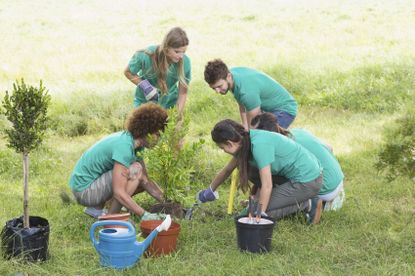8 Grant Writing Tips for Community Gardens
Funding for community garden grants is out there. Learn the ropes for writing grant proposals.


If you are a leader or stakeholder in a community garden, you are well aware of the challenges of managing resources. As much as we want to avoid talking about money in this context, securing funding can go a long way in improving deeper issues in your local plot.
It might sound tedious and futile to imagine expending much energy into fundraising, but sometimes it's just one of those things you have to do. The good news is that there are countless pockets of funding waiting for you--a multitude of organizations and people want to give people like you their money! Several organizations exist solely to fund communities like yours. Tapping into those sources takes time and a lot of practice, but keeping these eight tips in mind will help you produce a strategy for fundraising at your garden.
1. Firstly, and perhaps counterintuitively, make sure that you establish a variety of revenue streams coming into your garden, at least as a long-term fundraising strategy. In other words, don't depend on one big donor or one source of income to sustain your community. Money should be coming into your garden from a variety of directions, and organizations are actually more likely to offer you money if they can see that you are proactive in securing and managing your resources.
Don't go into the grant research process thinking that one grant will fix all your problems--instead, identify specific problems and look at fundraising around those issues. This leads us to the next tip...
2. Identify your garden's specific needs. The more specific your needs are, the more concrete your grant proposal will be. If you're looking to establish community, you might need to implement a series of programs that engage with people in your neighborhood or city. But even that isn't specific enough! Your grant proposal should actually discuss one program that the grant can support, and you should know exactly why that particular program will best serve your community. A struggling community garden is more fundable if the organizers can visualize where exactly the grant money would be allocated.
3. Research a variety of grants. When I say "variety," I mean variety in grant size and type. Sure, there are definitely $300,000 grants for community gardens out there, but there's a larger number of people vying for that money. So pick a handful of dream grants, ones that would really revolutionize your organization, but focus most of your energy on medium-sized grants. Also, be open to applying to a couple hundred-dollar range grants as well.
Capturing funds, no matter how small, will actually build a history of grant acquisition that will make you look good to potential grant givers down the road. Consider grant type as well. For example, a governmental or foundation grant might just expect you to lay out a vision for your garden, whereas a corporate grant might be more particular in what you have to do or implement to be considered.
Gardening tips, videos, info and more delivered right to your inbox!
Sign up for the Gardening Know How newsletter today and receive a free download of our most popular eBook "How to Grow Delicious Tomatoes."
Think national, and then think local. Shoot for bigger foundation grants open to people from anywhere, but also focus some time on local grants, if they're available. This research component is crucial to applying for grants that you can compete for. The more time you put into the research stage, the more targeted your writing process will be.
4. Once you have your grants researched, familiarize yourself with grant requirements. You might be exactly the organization a foundation or company is looking to support, but if you don't portray your end to align with the grant's requirements, you won't even be considered.
Try to imagine your garden from the funder's perspective:
Does your garden align with their values? Does your garden's mission reflect the goals of the funder? Is your garden similar to gardens that received a particular grant in the past? Try to pick grants that already fit with your garden's needs, which you should be well aware of.
Some grants favor established gardens that are expanding to incorporate new goals, like demonstrating conservation practices or implementing particular programs. Other grants focus on implementing types of gardens, like herb gardens or native gardens. Some grants advocate the professional development of garden leaders. Others push for incorporating a particular type of plant. Some grants support the enhancement of garden infrastructure. Before you even start brainstorming your grant proposal, you should know the grant inside and out--who the funder is, how they might see your organization, and how you'll have to frame your needs to align with their biases.
5. Focus on the positive. Generally, people apply for grants out of lack or need, but your grant application and proposal should highlight the positive effects to be made with this money. Show what you WOULD do or WILL do with grant money, not what you "can't" do without grant money.
Frame your garden in positive terms to show that you efficiently use what resources you've already secured. For example, say "my garden attempts to provide fresh produce to community schools," not "my garden can't give community schools as much as we want to give them." If your garden comes across as frazzled, or your tone is frustrated rather than hopeful, organizations might feel bad for you. But they won't necessarily trust you with their money.
6. Reflect on your mission throughout your grant proposal. Organizations like to work with organizations that are, well, organized! Show how your suggested activities and programs tie back to a clear mission that identifies the purpose your garden ultimately serves.
For example, if your mission is to educate gardeners on organic practices, you might want to implement an entirely organic greenhouse. In that case, your budget should clearly lay out what seeds or starts you will spend the money on, what materials you'll need to completely disavow inorganic chemical application, etc. Make sure you apply to grants from organizations or donors whose mission aligns with yours.
7. Spell out the impact of your garden or grant project. This is another good time to see your organization from their perspective. Remember that things that are important to one organization might not be that important to another organization. One way to bridge that gap is to use their language: look at how they frame and phrase their mission and values, and weave that language into your description of your garden's goals. You could have ten really great things you'd do with the money, but if they don't see why that's a good thing, they won't pay attention to you.
8. Keep a clear record of the grants you've applied for, the extent of your communication with the funder if you have any, and whether you secured the funding. You can do this using an Excel spreadsheet, with columns for the grant's title, summary of the grant, when you applied, whether they contacted you, and if you see ways to build a relationship with the organization in the future.
You might apply for a grant and be missing some crucial components, but perhaps the funder will offer that grant next year, and you can make some changes to more deeply align with those requirements.
The above article was paid for and sponsored by StoreStream LLC. The information contained in this article may contain ads or advertorial opinions.

Tiffany Horvath is a guest writer for Gardening Know How, specializing in community garden grant writing.
-
 How To Grow Garden To Table: A Guide For Home Cooks
How To Grow Garden To Table: A Guide For Home CooksWhat could be better than a meal that comes directly from garden to table? Show off your gardening and culinary skills with the very freshest food.
By Bonnie L. Grant
-
 Want a Backyard Mini Orchard? Create Your Own Container Orchard
Want a Backyard Mini Orchard? Create Your Own Container OrchardEasier to care for in small spaces, a backyard mini-orchard makes sense for busy gardeners and juicy fruit is the reward.
By Teo Spengler